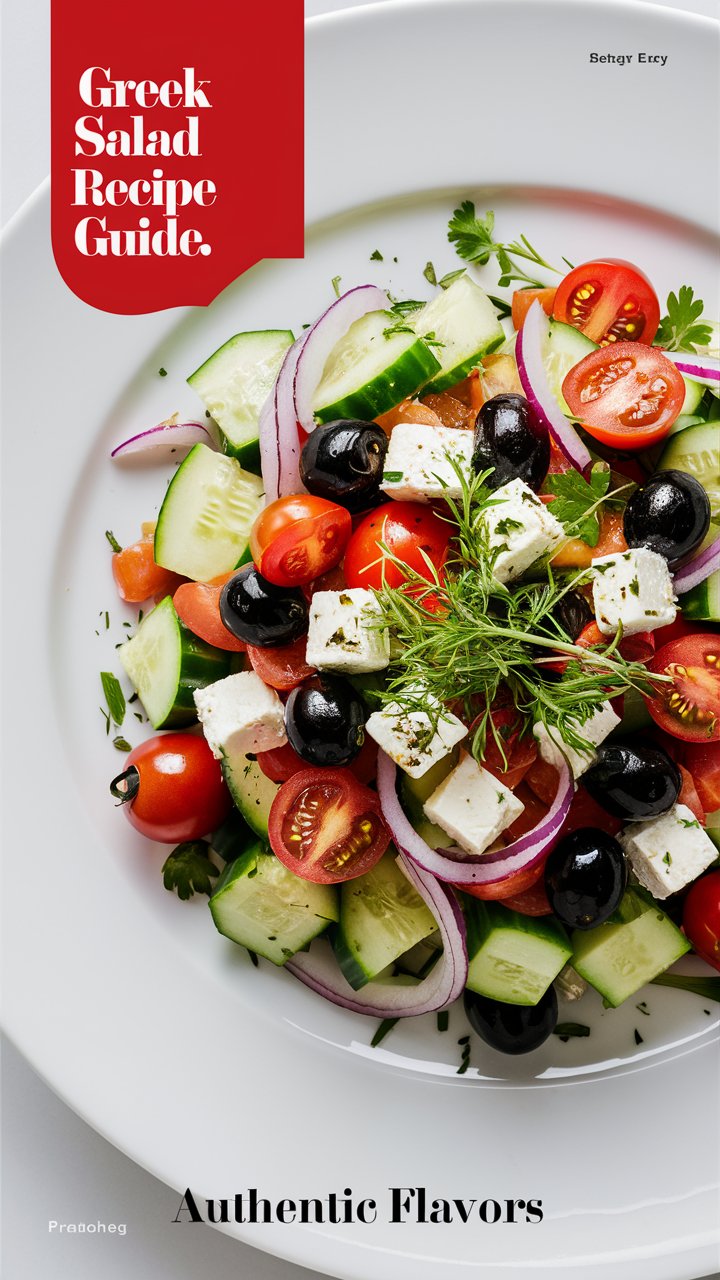Imagine sitting by the turquoise waters of the Aegean Sea, sun warming your face, and a crisp breeze dancing through olive trees. Now imagine taking a bite of something equally refreshing — a dish that bursts with color, crunch, and flavor. That, dear reader, is the magic of an authentic Greek Salad.
More than just a mix of vegetables, a Greek Salad — known traditionally as Horiatiki — is a celebration of Mediterranean culture. It’s fresh, healthy, simple, and endlessly versatile. Whether you’re planning a summer lunch, prepping a light dinner, or building a colorful side dish for your gathering, this salad fits the bill effortlessly.
In this comprehensive guide, we’re diving deep into:
- The origins and tradition of Greek salad
- The best ingredients (and why they matter)
- A step-by-step preparation method
- Authentic Greek dressing
- Customization ideas
- Nutritional insights
- Storage & make-ahead tips
- Frequently asked questions
Let’s bring a little Greek sunshine to your table.
What is Greek Salad (Horiatiki)?
Greek Salad, or Horiatiki Salata, originated in the rural villages of Greece. The word Horiatiki translates to “village-style,” which reflects the dish’s humble roots — simple, fresh, rustic, and made with ingredients grown locally. It was never meant to be complicated — just pure, wholesome produce brought together with minimal seasoning and maximum flavor.
Traditional vs. Modern Greek Salad
- Traditional Greek Salad: Typically includes tomatoes, cucumbers, red onion, green bell pepper, Kalamata olives, and a block of feta cheese on top — all drizzled with olive oil, oregano, and sometimes vinegar.
- Modern Variations: May include romaine lettuce, mixed greens, capers, or even avocado. These variations, especially outside Greece, are equally delicious and more adaptable to international palates.
Greek Salad Ingredients: A Breakdown of Flavor and Function
🥬 1. Romaine Lettuce (Optional, but Refreshing)
While not traditional in Greece, romaine adds volume and crunch — especially helpful if you’re serving a crowd. Use about 6–8 cups chopped, or skip it entirely for a more authentic take.
🍅 2. Tomatoes
Use ripe, firm grape or cherry tomatoes for sweetness and juiciness. Halved or quartered, they bring bold color and a juicy burst.
🧅 3. Red Onion
Thinly sliced red onion gives that peppery zing that balances the salad’s richness. If the taste is too sharp, soak slices in cold water for 10 minutes.
🫑 4. Green Bell Pepper
Crunchy and mildly sweet, green bell peppers are a staple in traditional Horiatiki salads.
🥒 5. Cucumber
Use Persian or English cucumbers for their thin skins and minimal seeds. Diced or sliced — your choice.
🫒 6. Kalamata Olives
These purple-black olives are rich and briny, adding depth to the overall taste. Always choose pitted for ease.
🧀 7. Feta Cheese
Creamy, crumbly, and tangy — authentic feta made from sheep or goat’s milk makes the salad shine. Cube it or serve in a large block over the top.
🥣 Homemade Greek Salad Dressing: The Game-Changer
Forget store-bought. This quick dressing recipe enhances every bite with balanced tang, sweetness, and herbaceous notes.
🌿 Ingredients for the Dressing:
- ¼ cup extra virgin olive oil
- 2 tablespoons red wine vinegar
- 1 tablespoon fresh lemon juice
- 1 teaspoon honey
- 1 teaspoon Dijon mustard
- 1 teaspoon dried oregano
- ¼ teaspoon kosher salt
- ¼ teaspoon black pepper
🥄 Instructions:
- Add all ingredients to a small mixing bowl or jar.
- Whisk (or shake) until fully emulsified.
- Taste and adjust salt, acidity, or sweetness as needed.
Pro Tip: Double the batch and store the rest for grilled meats or roasted veggies.
👩🍳 Step-by-Step Instructions: How to Make Greek Salad Perfectly Every Time
✅ Step 1: Prepare the Vegetables
- Wash all vegetables thoroughly.
- Chop romaine (if using), halve tomatoes, dice cucumbers, slice onions, and chop bell peppers.
- Pit and halve olives if needed.
- Cube feta or keep as a single block (traditional).
✅ Step 2: Assemble the Salad
- In a large mixing bowl, combine all the vegetables and olives.
- Gently toss for an even mix.
✅ Step 3: Add the Feta
- Add cubed or whole block of feta on top for presentation.
✅ Step 4: Dress and Toss
- Drizzle dressing over the top and toss just before serving.
- For guests, consider serving the dressing on the side.
🍽️ Serving Suggestions: What Pairs Well With Greek Salad?
- Grilled Chicken or Lamb: Protein-packed and Mediterranean-friendly.
- Warm Pita Bread: Soft and fluffy, perfect for scooping salad.
- Hummus or Tzatziki: Creamy dips balance the crisp veggies.
- Falafel or Dolmas: Traditional accompaniments.
- Chilled Rosé or Lemon Water: Refreshing drinks for summer months.
💡 Chef’s Tips and Tricks
- Use Quality Olive Oil: It makes a noticeable difference.
- Salt Tomatoes Separately: If prepping ahead, this keeps them from getting soggy.
- Don’t Overdress: Add dressing gradually to avoid mushiness.
- Customize Textures: Want crunch? Add sunflower seeds or chickpeas.
- Go Dairy-Free? Use plant-based feta substitutes — several taste remarkably similar.
🥗 Recipe Variations You’ll Love
🥑 Greek Salad with Avocado
Creamy avocado adds a buttery texture — just dice and mix gently.
🍗 Greek Chicken Salad
Add grilled chicken strips to turn it into a hearty meal.
🌱 Vegan Greek Salad
Skip the feta or use dairy-free feta alternatives.
🍠 Roasted Veggie Greek Salad
Add roasted zucchini, eggplant, or sweet potatoes for warmth and depth.
🩺 Nutritional Benefits of Greek Salad
Greek Salad isn’t just delicious — it’s incredibly healthy. Here’s why:
| Nutrient | Health Benefit |
|---|---|
| Tomatoes & Peppers | Rich in Vitamin C, supports immunity |
| Cucumbers | Hydrating, low in calories |
| Olives | Source of heart-healthy fats & antioxidants |
| Olive Oil | Anti-inflammatory & supports brain health |
| Feta Cheese | High in protein & calcium |
🧮 Approximate Nutrition per Serving:
- Calories: 380
- Fat: 33g
- Protein: 6g
- Carbohydrates: 10g
- Fiber: 3g
Note: Nutrition may vary based on portions and brands used.
⏳ Storage and Make-Ahead Tips
- Storing Leftovers: Store undressed salad in an airtight container in the fridge for up to 2 days.
- Dressing Shelf Life: Keep in fridge up to 7 days. Shake well before use.
- Meal Prep Tip: Keep chopped veggies and dressing separate. Combine just before serving for optimal freshness.
❓ Frequently Asked Questions (FAQ)
Q1: Can I make Greek Salad ahead of time?
Yes! Chop veggies and store separately. Add feta and dressing right before serving.
Q2: What’s the best substitute for feta cheese?
Use goat cheese, queso fresco, or plant-based alternatives if avoiding dairy.
Q3: Is Greek Salad low-carb and keto-friendly?
Absolutely! It’s naturally low in carbs and high in healthy fats.
Q4: Can I use other types of vinegar?
Yes — white wine or apple cider vinegar works, though red wine vinegar is most traditional.
Q5: Is Greek Salad gluten-free?
100% — it contains no gluten-based ingredients unless served with bread.
📌 Related Recipes You Might Enjoy
- Authentic Caesar Salad with Homemade Croutons
- Roasted Mediterranean Veggie Bowl
- Easy Tzatziki Sauce in 5 Minutes
- Crispy Falafel Wrap with Lemon Tahini Sauce
- The Perfect Hummus Recipe
✨ Conclusion: Your Go-To Mediterranean Salad Awaits
Greek Salad is more than just a bowl of vegetables. It’s an invitation to slow down, eat well, and celebrate fresh, honest ingredients. Whether you’re serving it as a quick weekday lunch or as a colorful dish at a party, it never fails to impress.
With its balance of crisp, creamy, tangy, and savory flavors, this salad brings the sun-drenched Mediterranean coast right to your kitchen. So next time you’re craving something satisfying yet light, whip up this Greek Salad and taste the difference homemade makes.



